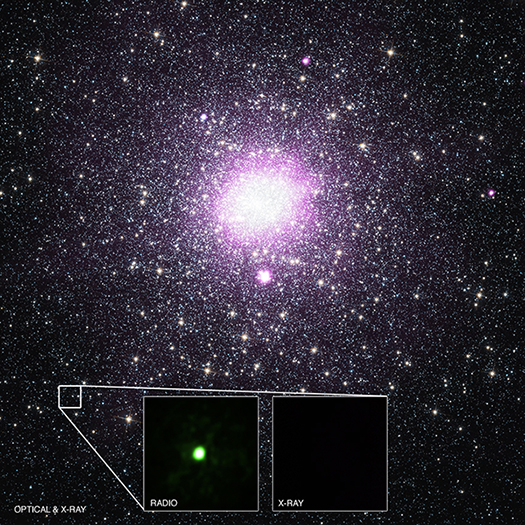Key Takeaways:
For about 20 years astronomers have known about the object VLA J213002.08+120904 (or VLA J2130+12 for short), but have never been able to quite nail down what the object was. In a new paper published in the Astrophysical Journal, scientists have finally decipheredr its strange radio emissions.
Using data from NASA’s Chandra X-ray Observatory, the Very Large Array (VLA), and the Hubble Space Telescope, astronomers have found that the source of this anomalous radio signals turns out to be a black hole x-ray binary. This system contains a black hole and a low-mass star, with the black hole sneakily eating material from its companion star without emitting x-rays, as happens in most similar binary pairs.
The discovery of a massive radio source at VLA J2130+12 was made over 20 years ago by the VLA in Socorro, N.M. This source was close enough to the globular cluster M15 that it was speculated to be related, but was assumed that it was probably in the background, said Gregory Sivakoff, a professor of physics at the University of Alberta.
A few years ago, astronomers used the European Very Long Baseline Interferometry Network (EVN), the Arecibo Observatory, and the NSF’s Green Bank Observatory to infer that VLA J2130+12 was not a background source at all. It was actually in front of the globular cluster at about only 7,200 light-years away, which is about five times closer than M15. It was assumed that it was an x-ray binary system, but then graduate student Robin Arnason, after studying the globular cluster, did not find any x-ray emissions near the source.
After noting this strange occurrence, a team lead by graduate student Bailey Tetarenko was created to study VLA J2130+12. This object was found to be very bright in radio sources but not in x-ray emissions. Using Hubble data, they found what they believed to be the emission from the companion star that the black hole was slowly eating from said Sivakoff.
“That suggested that we really were looking at one of these black hole x-ray binary systems,” says Sivakoff.
The reason this binary system was so elusive was because it did not possess the normal tell-tale signs of a black hole. Sivakoff described what happens under most conditions that give away the presence of a black hole.
“As material [from a star] falls onto the black hole it starts heating up and very close to the black hole it actually reaches millions of degrees and starts glowing brightly in the x-rays,” says Sivakoff. “Most of these [binary] systems were discovered when the star undergoes an eating frenzy and rapidly eats the material from this accretion disk and starts glowing brightly in the x-rays.”
For VLA J2130+12, this was not the case. This black hole, which is only a few times the mass of our own sun, is slowly eating away at its companion star and therefore not emitting x-rays. This is the first time a binary system like this was found outside a globular cluster in such a quiet state.
“In addition to x-ray emission, you can also get radio emission. Radio emission can also be one of the distinct signs of a black hole,” says Sivakoff. “In this case it really was the radio emission that lead us to this black hole.” -this quote may be closer to what we want
The next steps in this team’s plan is to validate, using optical light emanating from the accretion disk, and measure the mass of the black hole. Tetarenko is currently working hard on a proposal to make this research happen. The next step is to get a survey going to see if and how many other similar binary systems exist in the night sky.
“The specific way in which this object was found, we’ve only looked at a small bit of the sky. We’ve found one object and that implies that there are quite a large number of these,” says Sivakoff. “We estimate from between 26,000 to millions of these objects.”










